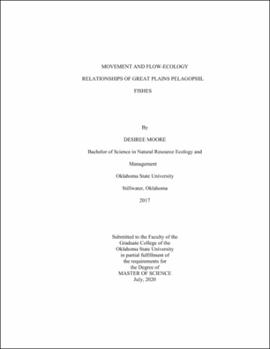| dc.contributor.advisor | Brewer, Shannon | |
| dc.contributor.author | Moore, Desiree | |
| dc.date.accessioned | 2021-02-22T22:41:19Z | |
| dc.date.available | 2021-02-22T22:41:19Z | |
| dc.date.issued | 2020-07 | |
| dc.identifier.uri | https://hdl.handle.net/11244/328660 | |
| dc.description.abstract | Alterations to freshwater systems are a leading cause of reduction in diversity and abundance of freshwater fishes. Pelagophils have been negatively affected by anthropogenic decreases in the frequency and magnitude of high-flow events and changes in baseflow conditions, but prescriptive flows based on pelagophil ecology are not available. Therefore, the goal of my thesis was to determine the flow components important for pelagophil persistence in the southern Great Plains. My first objective addressed how flow regime shapes pelagophil distributions over long periods of time by relating Arkansas River Shiner Notropis girardi and Plains Minnow Hybognathus placitus occupancy to flow regime components over cool and warm climatic periods. I found that pelagophils benefit from consistency in the number of high flow events and unpredictability in seasonal timing of high flow events. The relationships of Plains Minnow occupancy and predictability of seasonal flooding was dependent of the climatic regime, and may show that Plains Minnow is better able to adjust to warmer climate conditions. Disturbance and river fragmentation were negatively related to the occupancy of Arkansas River Shiner and Plains Minnow, respectively. To examine drivers of finer spatio-temporal dynamics and reveal the underlying factors affecting distributions, my second objective quantified movement of Arkansas River Shiner and Emerald Shiner Notropis atherinoides in the non-breeding season. Arkansas River Shiner and Emerald Shiner had a downstream movement bias in the winter and early spring. Long-distance upstream movements appear to be initiated in the spring by both species. I found evidence that a proportion of the Arkansas River Shiner population were residents by recapturing individuals in their tagging site after up to a year. If the goal is to conserve these species, water management strategies maintaining average annual (1983-2017) high-flow frequencies while promoting high-flow unpredictability may benefit these species. Land-use mitigation such as construction or recovery of wetland and riparian buffers may beneficial. Additionally, water management strategies improving river connectivity in late winter through the spawning season may benefit migratory individuals. However, improving lateral river connectivity in reaches with resident individuals (near river km 250) may increase recruitment from that proportion of the population. | |
| dc.format | application/pdf | |
| dc.language | en_US | |
| dc.rights | Copyright is held by the author who has granted the Oklahoma State University Library the non-exclusive right to share this material in its institutional repository. Contact Digital Library Services at lib-dls@okstate.edu or 405-744-9161 for the permission policy on the use, reproduction or distribution of this material. | |
| dc.title | Movement and flow-ecology relationships of Great Plains pelagophil fishes | |
| dc.contributor.committeeMember | Echelle, Anthony | |
| dc.contributor.committeeMember | Perkin, Joshuah | |
| osu.filename | Moore_okstate_0664M_16868.pdf | |
| osu.accesstype | Open Access | |
| dc.type.genre | Thesis | |
| dc.type.material | Text | |
| dc.subject.keywords | climate change | |
| dc.subject.keywords | flow ecology | |
| dc.subject.keywords | flow regime | |
| dc.subject.keywords | movement | |
| dc.subject.keywords | pelagic spawning fishes | |
| dc.subject.keywords | prairie fishes | |
| thesis.degree.discipline | Natural Resource Ecology and Management | |
| thesis.degree.grantor | Oklahoma State University | |
